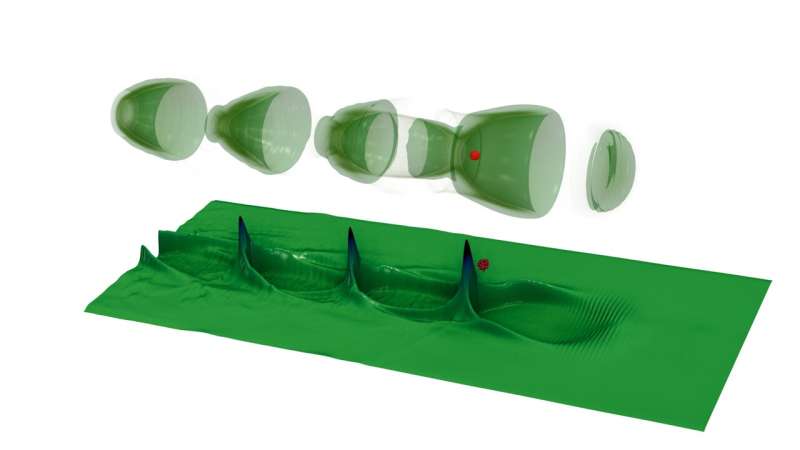The highly nonlinear plasma wave (green colored) driven by a strong laser pulse reaches the wave-breaking point, where a fraction of plasma electrons (red colored) are captured by the wakefield and get accelerated. Credit: Igor Andriyash, Yang Wan and Victor Malka.
Over the past few decades, physicists and engineers have been trying to create increasingly compact laser-plasma accelerators, a technology to study matter and particle interactions produced by interactions between ultrafast laser beams and plasma. These systems are a promising alternative to existing large-scale machines based on radio-frequency signals, as they can be far more efficient in accelerating charged particles.
While laser-plasma accelerators are not yet widely employed, several studies have highlighted their value and potential. To optimize the quality of the accelerated laser beam produced by these devices, however, researchers will need to be able to monitor several ultra-fast physical processes in real-time.
Researchers at the Weizmann Institute of Science (WIS) in Israel have recently devised a method to directly observe laser-driven and nonlinear relativistic plasma waves in real-time. Using this method, introduced in a paper published in Nature Physics, they were able to characterize nonlinear plasma at incredibly high temporal and spatial resolutions.
"Imaging a micrometric laser-driven plasma wave that runs at the speed of light is very challenging, implying the use of ultra-short pulses of light or bunches of charged particles," Yang Wan, one of the researchers who carried out the study, told Phys.org. "While the light can reveal structures in plasma density, the particle beams probe the internal fields of plasma waves and could thus give us much more information on the state of these waves, i.e., their capacity to inject and accelerate the plasma electrons."
The recent work by Wan and his colleagues is based on a previous proof-of-principle study he conducted with his former research team at Tsinghua University in China. This previous study essentially confirmed the feasibility of imaging weaker linear sinusoidal waves (i.e., natural representations of how many things and systems in nature change state over time).
"To directly observe the highly nonlinear plasma wave that is most popularly used for electron acceleration, we constructed two high-power laser-plasma accelerators using our dual 100 TW laser system at WIS," Wan explained. "This system produces a high-energy high-charge electron probe and the other produces a highly nonlinear plasma wakefield to be probed. In this exploratory study, we have tested this new imaging technique to its limits, looking for the fine field structures inside the nonlinear plasma waves."
The initial goal of the experiment conducted by Wan and his colleagues at WIS was to observe plasma waves in detail. After doing this, however, the team realized that nonlinear plasma waves deviated probe particles in more interesting and surprising ways, acting through both electric and magnetic fields.
"When deciphering this information with theoretical and numeric models, we identified the features that correlate directly with the dense electron spike at the rear of the formed 'plasma bubble,'" Wan said. "To the best of our knowledge, this is the first measurement of such fine structures inside the nonlinear plasma wave."
Wan and his colleagues subsequently increased the power of the driver laser used in their experiment. This allowed them to identify the so-called "wavebreaking," the state after which a plasma wave can no longer grow, so it instead captures plasma electrons in its accelerating field. Wavebreaking is a fundamental physical phenomenon, particularly in plasma.
"The first important achievement of our work is the imaging of the extremely strong fields of relativistic plasmas, as it exploits a unique feature of such laser-plasma accelerators—the few-femtosecond beam duration and micro-meter beam source size, which provide ultra-high spatiotemproal resolution for capturing the microscopic phenomena running at speed of light," Wan said. "By imaging the plasma wave, we also directly observed the subtle process of 'wavebreaking,' which itself was a wonderful experience."
Remarkably, the measurement collected by this team of researchers would be impossible to attain using any of the existing conventional accelerators based on radiofrequency technology. In the future, their work could thus inspire other teams to devise similar experimental methods for observing the many nuances of plasma further.
"Wavebreaking is also crucial for plasma-based accelerators, due to the production of relativistic electrons from self-injection," Wan said. "This injection mechanism is rather important in single-stage multi-GeV accelerators where it is hard to maintain the controlled injection over a long operation time."
This recent work by Wan and his colleagues could have numerous important implications for the development and use of laser-plasma accelerators. Most notably, it introduces a valuable tool to identify the electron self- injection process in real-time, which would allow researchers to fine-tune accelerators and improve the quality of their beams.
"We now have a unique and powerful tool to explore extreme fields for investigating many other fundamental questions in a wider range of plasma parameters that are relevant for physics including particle beam-driven wakefield, beam-plasma interaction and fusion-related plasma dynamics," Prof. Victor Malka, the principal investigator of the study and the group's lead researcher, told Phys.org. "The future is very exciting, and we are impatient to go deeper into the exploration of rich phenomena in plasma physics."
More information: Yang Wan et al, Direct observation of relativistic broken plasma waves, Nature Physics (2022). DOI: 10.1038/s41567-022-01717-6
Journal information: Nature Physics
© 2022 Science X Network
























